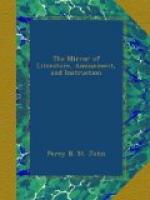which gives such perfect security to the pedestrian
even in our most crowded and tumultuous thoroughfare.
The causeway itself, on which walkers and drivers
are thus mingled together in confusion, is often most
uneven and rugged. The stones of which it is
formed, about ten inches square, present each a convex
surface, usually wet and slippery, so that under the
most favourable circumstances, walking in the streets
of Paris is anything but an agreeable exercise.
Still farther to abridge the level space, the street
is made to incline from both sides towards the centre,
in order to form there a sort of ditch, in which flows
a black and fetid stream. From the want of a
proper system of drains, this receptacle of filth
is generally sufficiently replenished even in the driest
weather, to keep the whole street wet and dirty.
Carriages, having usually one wheel in the midst of
the kennel, dash about the offensive puddle in all
directions. But the principle of a clear middle
way, such as our English streets possess, is neglected
in all the arrangements connected with those of Paris.
Even the lights, instead of being fixed on posts,
as ours are, at the sides, are suspended in the middle
on ropes swung across, and having their opposite ends
fastened to the walls of the houses. It was these
ropes which the mob, in the Revolution of 1789, were
wont to make use of as halters for their victims;
whence their famous cry of
a la lanterne, as
they dragged them along to execution.
The aspect of Paris by night, except in a few of the
principal streets where gas has been very partially
introduced, is singularly gloomy. The darkness
is occasionally relieved by the brilliancy of a cafe;
but in the more quiet parts of the town, particularly
in the fashionable quarter of the Faubourg St. Germain,
it is almost impossible for the pedestrian to direct
his steps aright. It is quite evident that the
arrangements of this capital have not been made for
a walking people. This evil, however, is fast
disappearing. Numerous passages have been
constructed, within the last ten years, which are paved
with flat stones, and brilliantly lighted; and the
active and pleasure-seeking population of Paris crowd
to these attractive and convenient places, to the
Boulevards, or to the Palais-Royal, and leave the narrow
and dirty streets principally to the few who keep
their own carriages, or to the many who hire public
conveyances. These are of various kinds; and
such was the growing importance of the middle classes,
that fiacres (so called after the sign of St
Fiacre, at the house where they were first established)
were in use a century and a half ago.
The remainder of the Part is occupied with a sketch
of the Revolution of 1789.
* * * *
*
REFORM OF EARLY PARLIAMENTS.




